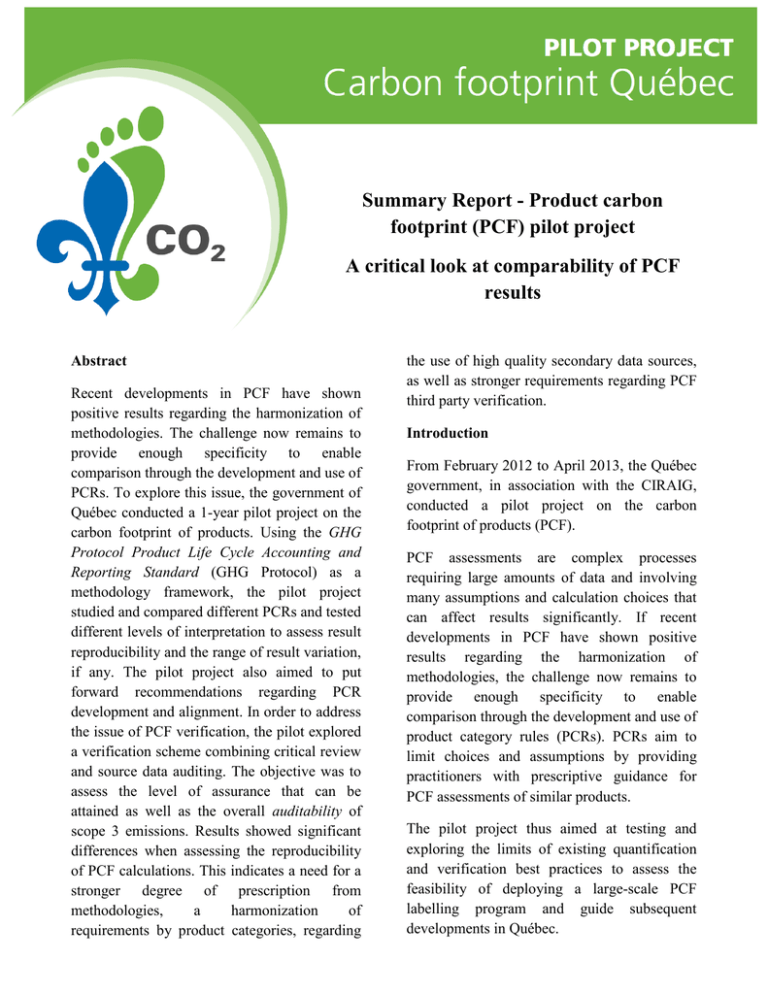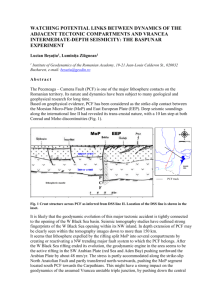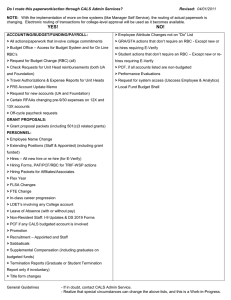Summary Report - Product carbon footprint (PCF) pilot project A
advertisement

Summary Report - Product carbon footprint (PCF) pilot project A critical look at comparability of PCF results Abstract Recent developments in PCF have shown positive results regarding the harmonization of methodologies. The challenge now remains to provide enough specificity to enable comparison through the development and use of PCRs. To explore this issue, the government of Québec conducted a 1-year pilot project on the carbon footprint of products. Using the GHG Protocol Product Life Cycle Accounting and Reporting Standard (GHG Protocol) as a methodology framework, the pilot project studied and compared different PCRs and tested different levels of interpretation to assess result reproducibility and the range of result variation, if any. The pilot project also aimed to put forward recommendations regarding PCR development and alignment. In order to address the issue of PCF verification, the pilot explored a verification scheme combining critical review and source data auditing. The objective was to assess the level of assurance that can be attained as well as the overall auditability of scope 3 emissions. Results showed significant differences when assessing the reproducibility of PCF calculations. This indicates a need for a stronger degree of prescription from methodologies, a harmonization of requirements by product categories, regarding the use of high quality secondary data sources, as well as stronger requirements regarding PCF third party verification. Introduction From February 2012 to April 2013, the Québec government, in association with the CIRAIG, conducted a pilot project on the carbon footprint of products (PCF). PCF assessments are complex processes requiring large amounts of data and involving many assumptions and calculation choices that can affect results significantly. If recent developments in PCF have shown positive results regarding the harmonization of methodologies, the challenge now remains to provide enough specificity to enable comparison through the development and use of product category rules (PCRs). PCRs aim to limit choices and assumptions by providing practitioners with prescriptive guidance for PCF assessments of similar products. The pilot project thus aimed at testing and exploring the limits of existing quantification and verification best practices to assess the feasibility of deploying a large-scale PCF labelling program and guide subsequent developments in Québec. Method Twelve companies took part in the pilot project during which they assessed the carbon footprint of one or more of their products using the GHG Protocol and relevant sector guidance (PCR when available). The assessments were then third-party verified using two types of verification mechanisms, critical review and source data audit. Critical review validated the compliance of PCF calculations with methodology and sector guidance using checklists and comment forms. On-site source data audits, carried out by the Bureau de Normalisation du Québec (BNQ), verified the level of assurance that one could get towards the data and the PCF result. Finally, different methodological tests were conducted to evaluate the reproducibility and comparability of product carbon footprint calculations. Tests conducted during the pilot project aimed to assess the level precision of existing PCRs and thus the level of comparability of PCF results. To do so, the entire PCF calculation process was duplicated over 3 products. Two practitioners, working independently, were given the mandate to calculate the PCF of a product, using the same PCR and framework methodology and having access to the same raw primary data. The main difference was that one of the practitioners was given a direct contact to the company. After undergoing critical review by an independent auditor, both assessments were compared and differences were evaluated and analyzed. The exercise was therefore able to explore the precision of existing methodologies and quantify the possible impact on results of choices and assumptions made by the quantifier. Results Results show that, for a same product, significant variations may occur between the two PCF calculations. PCF values for a same product were in one case more that 100 % different than the initial assessment. Divergences were due to the use of various databases and to the differences regarding modeling of multifunctional processes, as well as the definition of distribution, use and end-oflife profiles. These observations indicate that, in all three cases tested, methodological standards needed to be more prescriptive on these methodological key issues in order to promote the reproducibility and comparability of PCF calculations and results. It must be noted both PCF assessments were third-party verified and PCR compliant. Though requirements are not uniform and no international standard specifically governs PCF verification, third party verification increases the credibility of an assessment. During the pilot project, it contributed to increase the quality of the study. Furthermore, the dualcomponent approach tested during the pilot showed that the objectives of a critical review and of a source date audit are complementary and contribute to an exhaustive verification. However, experts involved in the verification process consider this approach as an extensive but time consuming process. In addition, primary data upstream or downstream of the production site are particularly difficult to verify. For example, access to supplier data has proved to be challenging. Moreover, tests indicated a need for a stronger degree of prescription from methodologies, a harmonization of requirements, by product categories, regarding the use of high quality secondary data sources, as well as stronger requirements regarding PCF third party verification. That is to say that comparability will be promoted through stronger methodological requirements which may, in turn, consolidate the validity and the credibility of carbon footprint labelling. Conclusion Results showed significant differences when assessing the reproducibilityy of PCF calculations. This indicates a need for a stronger degree of prescription from methodologies, a harmonization of requirements by product categories, regarding the use of high quality secondary data sources, as well as stronger requirements regarding PCF third party verification. Further tests would be required in order to draw broader conclusions about result comparability. However, findings indings indicate that the current state of science is not favorable to labeling aimed at comparability or to the development of a consumer oriented Québec certification program, as was initially considered considered. Despite these challenges, the assessment of a product’s carbon footprint remains relevant for companies. On one hand, it is the only available method that provides a quantified and holistic snapshot of a product’s impact on climate change. Also, assessing the carbon footprint of their products provides companies with considerable environmental and economical benefits that do not require consistent comparability ity of results. In particular, PCF can be used as a valuable decision making tool. Companies ompanies can acquire a better understanding of their products and value chain, as well as help them identify environmental hotspots. Companies can then identify opportunities opportuniti to reduce costs, resource use and greenhouse gas emissions, better manage risks, foster innovation and eco-design, design, and increase the credibility of environmental and sustainably efforts. Moreover, PCF and life cycle assessment represent strong market trends to which companies must respond to ensure long term success. Thus, PCF evaluation remains a very attractive tool for Québec going forward to increase the competitiveness and productivity of businesses and to promote Québec’s low carbon hydroelectricity grid. Considering the main findings of the pilot project, ensuing recommendations will mainly focus on contributing to the advancement of knowledge and to the development and harmonization of best practices, while providing Québec companies es with the necessary tools to help them take advantage right away of the benefits offered by PCF. contact: For more information,, please contact Sophie FALLAHA, M.Sc.A. Senior analyst CIRAIG T. +1 514.340.4711 #4987 sfallaha@polymtl.ca www.ciraig.org Peter EDWARDS Adviser Ministère des Finances et de l'Économie T. +1 418.691.5698 #4326 peter.edwards@mfeq.gouv.qc.ca www.economie.gouv.qc.ca/bilanprojetempreintecar bone





